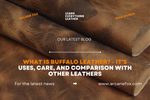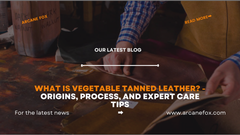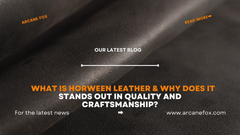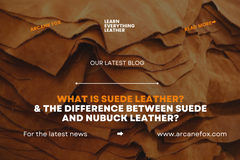What is Suede Leather? & The Difference Between Suede and Nubuck Leather?
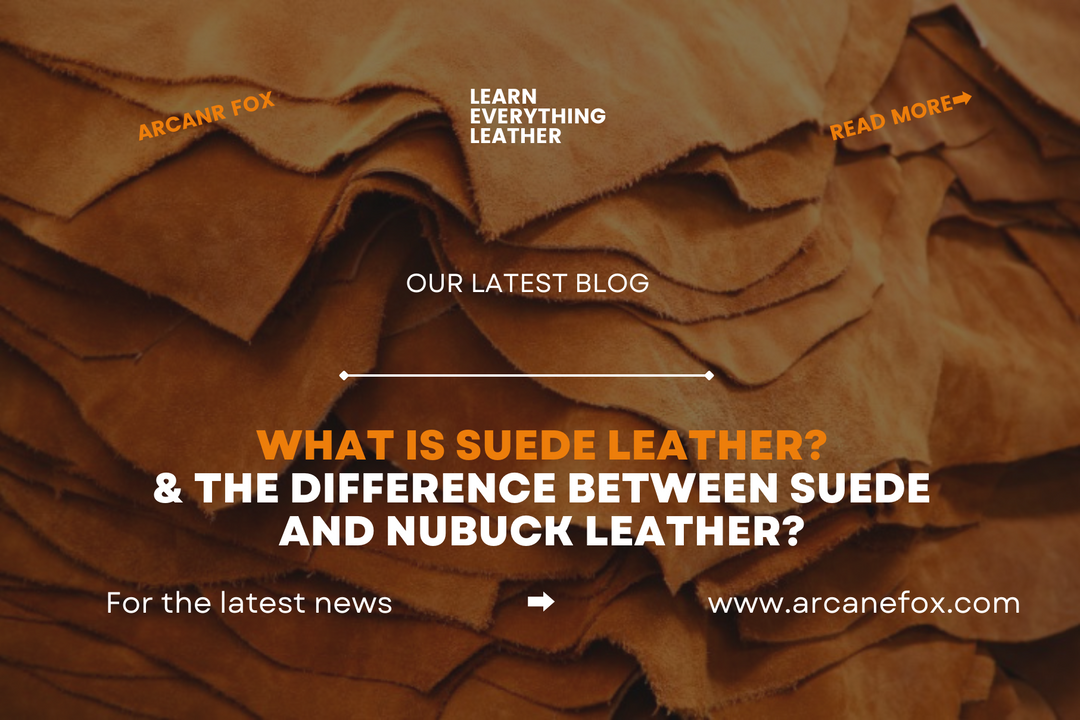
What is Suede Leather? & The Difference Between Suede and Nubuck Leather?
We have all seen and heard about suede many more times than we can possibly count. Who wants a killer leather or suede jacket? Even though we agree that it has an awesomely opulent appearance and feel, not to mention the variety of hues they come in, we don't really know much about it. In this blog post, we discuss a few key suede characteristics that will help us gain a new understanding of one of the most well-known leather varieties in history.
What to Expect for this blog?
In this blog, we delve into the world of suede leather, uncovering its origins, how it's made, and why it's called "suede." We also explore the key differences between suede and nubuck leather, the various types of suede, and its common uses in fashion and accessories. You'll learn about the care and maintenance of suede, including cleaning, conditioning, and waterproofing. We even address the age-old question of whether suede is real leather. So, whether you're a suede enthusiast or just curious about this luxurious material, join us on a journey through the soft, fuzzy, and stylish world of suede leather.
1. What is Suede Leather?

Suede leather is one type of leather with a smooth, velvety surface. The central layer or layers of a thick hide that has been split into multiple thinner layers are typically use to make it. Suede will be made from the side of the hide that was formerly closer to the animal on thinner skins. The "flesh side" or "underside" are other names for this.
It stands out from the majority of leathers because the surface is cover in numerous tiny higher leather fibers. Although it has smooth, very short, compact fibers, it is practically "fuzzy". The Full Grain and Top Grain layers of leather have thick, strong fibers. Suede-making fabrics are typically more open and loose. More information on why will be available below.
These fibers rise and split during the sanding process, giving the leather its "fuzzy" appearance. Let's examine the many leather layers and the exact origin of suede. These fibers are reasonably strong and resistant to wear because they are made from natural leather.
2. The Origins of Suede Leather
Animal hides have been quite frequently use to create clothes and household items since the Paleolithic era. The Industrial Revolution was the only time that leather underwent a significant transformation, which was driven by the introduction of various new types of tanning chemicals that have since been proven to be crucial to the production of leather.
In particular, suede didn't reach its peak of popularity until the 20th century. The fashion industry has played up its delicate yet opulent quality, look, and feel, which has contributed to its status as a status symbol. For this reason, many people are constantly looking for the best suede leather jackets available.
3. Why is it Called Suede?
It has been thought that the word "suede" comes from a literal reference. Fine ladies' leather gloves began to be made in Sweden around 1859. They were very soft, plush, and luxuriant with a raised fiber nap.
They were refer to as "gants de Suède" by the French, which is French for "gloves of Sweden". The reference persisted as a result of the unusual material's global popularity. The term "Suede" was thereafter use to describe any soft leather having elevated fibers on the nap.
Finding any genuine sources from the time, such as newspapers or journals that mentioned the new gants de Suède, would be fascinating.
4. How is Suede Leather Made?

The process of tanning leather produces suede leather. Depending on the procedure working, tanning can take anywhere from days to months and involves up to 25 processes. Suede leathers are frequently tan utilizing a quick-tanning (chrome tanned) method that uses chromium. Leathers made through chrome tanning are known for being supple and flexible.
Leathers made from chromium tanning also take and keep colored dye reasonably well. This results in a very aesthetically pleasing, soft leather that may be made into a variety of leather products, such as bags, gloves, purses, wallets, and other high-end leather items and accessories. Suede leathers are both physically soft and aesthetically beautiful because they come in a variety of colors.
Given that sanding produces the elevated fibers, the procedure can be use on either one or both sides of the leather. It is referred to as "double-sided suede" when use on both sides. It is refer to as "suede" or "single-sided" suede when apply to only one side.
5. What Hides are Made Into Suede Leather?
Today, calves (young cows), lambs (young sheep), and youngsters (young goats) are most frequently used to produce suede. Animals that are larger or older, such cows, deer, sheep, and goats, typically have thicker skins that produce slightly rougher elevated fiber (nap). So it is suggest to use the softer and finer hides from calf, lambs, and young animals. However, almost any hide can be use to create suede.
6. Why is Suede Leather Made from The Underside of Leather?
The tightest, densest grain typically occurs in the layers of hide that are closest to the surface. This is due to the fact that the animal was protect by the skin that was closest to the ground. This can be the result of exposure to the sun, wind, rain, or daily abrasions.
The skin may hold more as one descends into its deeper layers, including fatty tissue and other organic materials. As a result, the collagen fibers were more flexible to accommodate all of these materials. Simply because the fibers are less dense, the leather from these layers, such as Split Leather, is not as robust as Top Grain and Full Grain leather.
To create the raised-fiber, texture side of suede leather, thick fibers on the inner surface (the "flesh side") of a leather cut from the corium of the hide are sand. The slightly loose fibers produce a surface of leather fiber that is fuzzy.
It's important to remember that a leather called Nubuck is comparable. The outside (grain side) of nubuck is what is polish to create it. This is so that the leather fibers are more tightly woven the closer it is to the hide's original surface. As a result, top grain leather is use to create nubuck, which makes use of the exterior. Suede fibers are less compact and tightly woven than Nubuck.
In general, nubuck leather is more expensive than suede. This is so that Nubuck's tighter grain, which is a little stronger and more durable, may be use. Also, it appears a little smoother. Therefore, a greater price also reflects these desired attributes.
7. Types of Suede Leather
Similar to the variety of leathers, there are several types of suede leather according to the skin or hide from which they come about.
Sheepskin Suede Leather

Because sheepskin leather is lighter and softer than its older substitutes, this type of suede leather, for example, is primarily made from lambskin. Suede can also be produce from sheepskin, but the finished product will look and feel substantially different.
Goatskin Suede Leather
Goatskin suede leather is a velvet-like leather type, which is often use for leather clothing. It is very light and comfortable. Goat suede is used for leather jackets, skirts or pants. Long leather glove made of soft goatskin suede.
Cowhide Suede Leather

Cowhide suede leather exhibits the exact same qualities as sheepskin and lambskin suede; it shares the same characteristics. Comparatively speaking, calves typically have softer hides than mature cows. Although cowhide leather offers excellent toughness in leather, calf hides provide the nap and softness necessary for suede leather. Similar to our last statement, cowhide can be use to manufacture suede, but there is a definite difference in the way it looks and feels.
Pigskin Suede Leather
Pig skins are dye and suede to create this particular style of suede. Technically, it has a heavy, stiff skin with short naps and pores that mimic human skin. But like suede, it is strong, resilient, and long-lasting. Although it is not just use to make those things, pigskin suede leather is frequently use to make work gloves, shoes, bags, wallets, and other accessories.
8. What Is Suede Leather Used For?

Suede leather is usually chosen for apparel and fashion accessories because it is softer and thinner than ordinary leather.
Loafers, slides, and boots look and feel good because of suede's smooth nap. For their comfort and personality, suede boots are particularly well-like. In addition to being more durable than regular leather, suede is also lighter, which makes it a good material for footwear.
Since it was first used for gloves, suede has grown in popularity for belts, handbags, and other kinds of accessories. Suede is a preferred fabric among fashion designers for accent items like purses and belts due to its distinctive appearance.
A suede jacket is a fashion must because of its lovely suede texture and durability, and it is famously use in western fringe jackets.
- Handbags
- Luggage
- Pouches
- Jackets
- Watchbands
- Keychains
- Purses
- Dresses
- Automobile Upholstery
- Sandals
- Boots
- Shoes
- Belts
- Wallets
- Furniture Upholstery
- Gloves
- Briefcases
- Travel Bags
- Notebook Covers
- Mobile Electronic Device Covers and Cases
9. Levels of Quality Suede Leather

Although suede is a high-grade material, its quality is not assess or characterize in the same way as that of other types of leather. It's interesting to note that the age of the animal's skin or hide used to create the suede affects its level of excellence. Suede has become so popular because, on the one hand, sheepskin is a perfect supply for it. Conversely, although cowhide may also be made to manufacture suede, few people actually prefer it.
The extent to which the leather is split is another factor that impacts suede quality. Even though full grain leather is still intact, it won't create a nice suede since it isn't flexible, despite being strong and resilient. However, if the leather is split, it helps to get the suede's ideal soft and supple surface.
10. What Are the Advantages of Suede?
- Durable: When compared to fabric textiles, suede is an extremely robust and long-lasting material. Due to its thinness, suede has a lovely, delicate drape.
- Smooth appearance: Suede has a silky nap and a soft hand, making it a desirable fabric.
- Pliable: Suede is a soft leather that is easily molded to create garments and accessories like purses and jackets. Dresses can be made from leather that is thinner because it drapes nicely.
- Long-lasting: Given that suede is a type of leather, it has a very long lifespan.
11. What Are the Disadvantages of Suede?
- Thin: Due to its thinness, suede is less durable than regular leather, which is one of its main advantages.
- Easily damaged: Suede's nap can attract dust and debris, harming its smooth appearance and making it appear readily unclean.
12. What's the Difference Between Nubuck and Suede?

Like regular leather, nubuck is a soft leather create from the top grain of the animal hide. To give it a smooth surface, nubuck is sand down. Suede is less expensive than nubuck leather. While suede can be made from cow skin, it is less popular since cowhide produces a rough texture. Nubuck is typically made from cowhide. Suede is thinner and weaker than nubuck. Both nubuck and suede can be treat at home or by the manufacturer to make them more water resistant despite not being naturally waterproof.
13. What's the Difference Between Microsuede and Suede?
A type of faux leather with a suede-like texture is known as microsuede fabric; it is made up of polyester fabric. One of the most common types of imitation suede is microsuede, which is soft, water-resistant, lightweight, stain-proof, and simple to maintain. Especially in households with children and dogs, microsuede is popular for home design, such as furniture upholstery fabric, as the faux suede material is durable and easier to clean than suede.
14. Suede Leather Care & Maintenance
Every piece of leather goods, particularly suede leather, needs to be clean and taken care of properly. Keeping the surfaces clean and restoring/conditioning them with oils can help them stay strong and look fantastic because they are made of natural fibers.
One thing to keep in mind is that you should always test any leather care step on a tiny area first to make sure the cleaning or finish won't react negatively with the leather. Clean away as soon as you're certain it's secure.
Raw suede leather is particularly sensitive to cleaning agents. Even big drops of water have the ability to permanently discolor the material, but not frequently.
How to Clean Suede Leather?

In general, suede leather can be clean by applying pressure to the surface with a wet, lint-free cloth. The best way to do this is to move in a variety of straight directions. This will help transport dirt and debris away while preventing it from encrusting the fibers more because there is a nap of elevated fibers.
The leather material may temporarily get darker as a result of some moisture from the damp towel, but it will eventually air-dry off the surface. Even while it might appear that any water will instantly produce a stain, it typically takes more than a damp towel to leave any traces that are noticeable.
A specialist leather cleaner might be a good option if the dirt is more permanent, it contains challenging stains, or you want to fully clean the leather. To choose a leather soap that is delicate enough to clean without causing damage, look for one made for very soft leathers, particularly suede.
How to Condition Suede Leather?
The leather fibers dry out more quickly on suede leather than other types of leather if no surface treatments are apply. Therefore, it's crucial to condition raw suede leather more frequently.
Usually, this entails slathering the leather with wax, oil, or cream and allowing it to absorb it. The leather feels better in the hand and is more flexible, soft, and scratch-resistant after conditioning. Apply the conditioner in straight, varying-direction strokes across the surface, much like you would while cleaning it. Since the surface has a nap of elevated fibers, the conditioner will be distribute more evenly and won't be concentrate in one spot as much.
Using an applicator, a soft cloth, or a brush, the conditioner can be put after the surface has been well cleaned. Make sure the brush is extremely soft and made for use on suede leather. A clean, lint-free cloth can be use to remove any excess conditioner.
If you want, a protective coating might be put at this point. The advantage is that it will make the leather slightly more scratch- and water-resistant. The potential drawback is that it might add a layer to the leather's surface, hiding some of the appealing features of natural leather's feel and appearance. Natural or synthetic waxes or acrylics with protective coatings help to make the surface water resistant.
How to Waterproof Suede Leather?

It is possible to waterproof a suede leather product if you want to use it in extremely damp situations or if you made a piece that you'd like to preserve from the elements.
It can be given a wax protectant to help make it more water resistant. The leather can be properly wax after being clean and condition. The wax is often polish out after a few minutes, leaving the leather with a smooth surface and a pleasing shine. It also offers a barrier that aids in deterring water.
Acrylics or synthetic protectants can be put to the leather surface for longer-lasting and more durable finishes. However, it becomes more challenging to later access, clean, and condition the leather underlying the thicker coating of water proofing (often a form of wax).
How to Fix a Scratch on Suede Leather?
Scratches in leather can be fix and repaired in a few different methods. Generally, depending on how big and deep the scratch is, you'll try a simpler procedure before going on to the next. Adding oils back into natural leather is typically the first thing to attempt when trying to mend a scratch because it has numerous fibers and previously had oils in the skin.
Rub your finger over a small scratch to try to buff it out. Apply leather conditioner to the scratch and the surrounding area if the scratch is deeper, then buff it out after a short while.
Try brushing the leather fibers (with a soft, suede-safe leather brush) if that doesn't work. It might modify the fibers sufficiently to partially or even completely cover the scratch.
It could be necessary to use a leather filler kit if the scratch is particularly large or deep. Typically, they contain a material that may be use to fill in leather cuts and cracks. The material typically offers color matching possibilities, giving it a similar visual appearance to the current leather. Follow the detailed directions on the package, although often the surface can be condition and smooth after drying.
How to Store Suede Leather?
Most leather should be kept in a place that is cool, dry, and free of dust. Low-average humidity settings are often advantageous for leather products. The ability for the leather's natural fibers to "breathe" is another advantage of air flow.
If kept in a closed space, the humidity may increase, causing the leather to start to break down and mold. The leather may begin to dry up in an atmosphere with too little humidity, which may cause cracking and weakening of the fibers. If suede boots or shoes are damp, make sure they have had enough time to completely dry out (often up to 24 hours) before storage.
A dressing room or closet with a typical habitable temperature, humidity level, and regular circulation is an ideal area to store suede leather. Storage bags are include with several leather products. Typically made of permeable material, they aid in keeping you sealed off. If one of these is accessible, storing it there can be a terrific option.
Because of its raised and fuzzy surface, suede leather is a special kind of leather. Suede gives a surface that will stand out visibly and perform admirably for years when contemplating options for a leather project or new leather good acquisition.
15. Conclusion
We now understand what suede leather actually is, bringing this topic on to a close. The suede leather jacket has a brief history before becoming one of the most popular outerwear items in the world. The process of manufacture and varieties of suede leather. In addition, we've had a chance to outline some notable benefits and drawbacks of this well-known, classic type of leather.
Learn more about leather here Leather 101 - The Ultimate Guide to Different Types of Leather
Related Topics
- What is Aniline Leather? Types of Aniline, Characteristics, And More
- What is Semi-Aniline Leather? History, Characteristics, And More
- What is Burnished Leather? & Why Should It’s Be Your Top Choice
- What is Antique Leather? & Why it is So Popular
- What is Bicast Leather? Myths, Facts, and Benefits
- What is Embossed Leather? & How to Use This Process
- What is Embroidery Leather? & What to Look for In Leather Embroidery?
- What is Faux Leather? It’s Quality & Durability Against Other Leather!
- What is Nappa Leather? Quality, Characteristics, and Maintenance
- What is Nubuck Leather? & How is it Different From Suede Leather
- What is Oil or Pull-Up Leather? It’s Durability, Characteristics, and Maintenance
- What is Patent Leather? & How to Maintain It’s Quality and Shining
- What is Pigmented Leather? How is it Made, It's uses and characteristics


